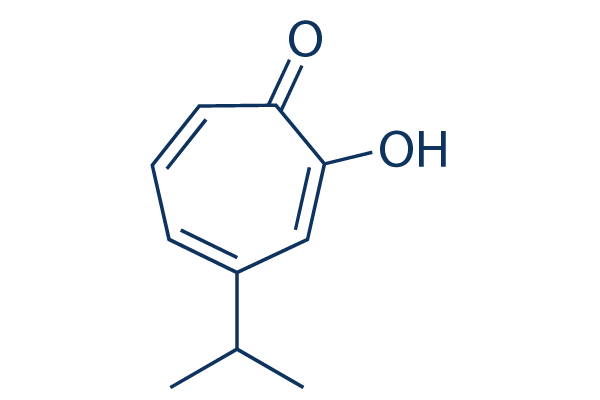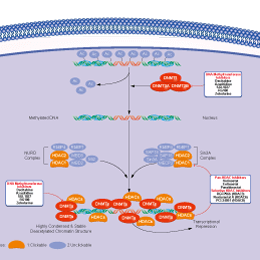
- Bioactive Compounds
- By Signaling Pathways
- PI3K/Akt/mTOR
- Epigenetics
- Methylation
- Immunology & Inflammation
- Protein Tyrosine Kinase
- Angiogenesis
- Apoptosis
- Autophagy
- ER stress & UPR
- JAK/STAT
- MAPK
- Cytoskeletal Signaling
- Cell Cycle
- TGF-beta/Smad
- Compound Libraries
- Popular Compound Libraries
- Customize Library
- Clinical and FDA-approved Related
- Bioactive Compound Libraries
- Inhibitor Related
- Natural Product Related
- Metabolism Related
- Cell Death Related
- By Signaling Pathway
- By Disease
- Anti-infection and Antiviral Related
- Neuronal and Immunology Related
- Fragment and Covalent Related
- FDA-approved Drug Library
- FDA-approved & Passed Phase I Drug Library
- Preclinical/Clinical Compound Library
- Bioactive Compound Library-I
- Bioactive Compound Library-Ⅱ
- Kinase Inhibitor Library
- Express-Pick Library
- Natural Product Library
- Human Endogenous Metabolite Compound Library
- Alkaloid Compound LibraryNew
- Angiogenesis Related compound Library
- Anti-Aging Compound Library
- Anti-alzheimer Disease Compound Library
- Antibiotics compound Library
- Anti-cancer Compound Library
- Anti-cancer Compound Library-Ⅱ
- Anti-cancer Metabolism Compound Library
- Anti-Cardiovascular Disease Compound Library
- Anti-diabetic Compound Library
- Anti-infection Compound Library
- Antioxidant Compound Library
- Anti-parasitic Compound Library
- Antiviral Compound Library
- Apoptosis Compound Library
- Autophagy Compound Library
- Calcium Channel Blocker LibraryNew
- Cambridge Cancer Compound Library
- Carbohydrate Metabolism Compound LibraryNew
- Cell Cycle compound library
- CNS-Penetrant Compound Library
- Covalent Inhibitor Library
- Cytokine Inhibitor LibraryNew
- Cytoskeletal Signaling Pathway Compound Library
- DNA Damage/DNA Repair compound Library
- Drug-like Compound Library
- Endoplasmic Reticulum Stress Compound Library
- Epigenetics Compound Library
- Exosome Secretion Related Compound LibraryNew
- FDA-approved Anticancer Drug LibraryNew
- Ferroptosis Compound Library
- Flavonoid Compound Library
- Fragment Library
- Glutamine Metabolism Compound Library
- Glycolysis Compound Library
- GPCR Compound Library
- Gut Microbial Metabolite Library
- HIF-1 Signaling Pathway Compound Library
- Highly Selective Inhibitor Library
- Histone modification compound library
- HTS Library for Drug Discovery
- Human Hormone Related Compound LibraryNew
- Human Transcription Factor Compound LibraryNew
- Immunology/Inflammation Compound Library
- Inhibitor Library
- Ion Channel Ligand Library
- JAK/STAT compound library
- Lipid Metabolism Compound LibraryNew
- Macrocyclic Compound Library
- MAPK Inhibitor Library
- Medicine Food Homology Compound Library
- Metabolism Compound Library
- Methylation Compound Library
- Mouse Metabolite Compound LibraryNew
- Natural Organic Compound Library
- Neuronal Signaling Compound Library
- NF-κB Signaling Compound Library
- Nucleoside Analogue Library
- Obesity Compound Library
- Oxidative Stress Compound LibraryNew
- Plant Extract Library
- Phenotypic Screening Library
- PI3K/Akt Inhibitor Library
- Protease Inhibitor Library
- Protein-protein Interaction Inhibitor Library
- Pyroptosis Compound Library
- Small Molecule Immuno-Oncology Compound Library
- Mitochondria-Targeted Compound LibraryNew
- Stem Cell Differentiation Compound LibraryNew
- Stem Cell Signaling Compound Library
- Natural Phenol Compound LibraryNew
- Natural Terpenoid Compound LibraryNew
- TGF-beta/Smad compound library
- Traditional Chinese Medicine Library
- Tyrosine Kinase Inhibitor Library
- Ubiquitination Compound Library
-
Cherry Picking
You can personalize your library with chemicals from within Selleck's inventory. Build the right library for your research endeavors by choosing from compounds in all of our available libraries.
Please contact us at [email protected] to customize your library.
You could select:
- Antibodies
- Bioreagents
- qPCR
- 2x SYBR Green qPCR Master Mix
- 2x SYBR Green qPCR Master Mix(Low ROX)
- 2x SYBR Green qPCR Master Mix(High ROX)
- Protein Assay
- Protein A/G Magnetic Beads for IP
- Anti-Flag magnetic beads
- Anti-Flag Affinity Gel
- Anti-Myc magnetic beads
- Anti-HA magnetic beads
- Poly FLAG Peptide lyophilized powder
- Protease Inhibitor Cocktail
- Protease Inhibitor Cocktail (EDTA-Free, 100X in DMSO)
- Phosphatase Inhibitor Cocktail (2 Tubes, 100X)
- Cell Biology
- Cell Counting Kit-8 (CCK-8)
- Animal Experiment
- Mouse Direct PCR Kit (For Genotyping)
- New Products
- Contact Us
β-thujaplicin
Synonyms: Hinokitiol, 4-Isopropyltropolone
β-Thujaplicin (β-TH, Hinokitiol, 4-Isopropyltropolone) is a toxic tropolone derivative present in the heartwood of western red cedar (Thuja plicata) and is used as a preservative and antimicrobial additive in a number of commercial goods. Hinokitiol is a component of essential oils isolated from Chymacyparis obtusa, reduces Nrf2 expression, and decreases DNMT1 and UHRF1 mRNA and protein expression, with anti-infective, anti-oxidative, and anti-tumor activities.

β-thujaplicin Chemical Structure
CAS: 499-44-5
Selleck's β-thujaplicin has been cited by 1 publication
Purity & Quality Control
Batch:
Purity:
99.82%
99.82
β-thujaplicin Related Products
| Related Targets | TET DNMT1 DNMT3 | Click to Expand |
|---|---|---|
| Related Compound Libraries | Kinase Inhibitor Library FDA-approved Drug Library Natural Product Library Bioactive Compound Library-I Bioactive Compound Library-Ⅱ | Click to Expand |
Signaling Pathway
Choose Selective DNA Methyltransferase Inhibitors
Biological Activity
| Description | β-Thujaplicin (β-TH, Hinokitiol, 4-Isopropyltropolone) is a toxic tropolone derivative present in the heartwood of western red cedar (Thuja plicata) and is used as a preservative and antimicrobial additive in a number of commercial goods. Hinokitiol is a component of essential oils isolated from Chymacyparis obtusa, reduces Nrf2 expression, and decreases DNMT1 and UHRF1 mRNA and protein expression, with anti-infective, anti-oxidative, and anti-tumor activities. |
|---|
| In vitro | ||||
| In vitro | In lung cancer cells, hinokitiol inhibits cell proliferation by inducing the p53-independent DNA damage response, autophagy (not apoptosis), S-phase cell cycle arrest, and senescence. Hinokitiol induces autophagy in lung adenocarcinoma cells but not in human lung stromal fibroblasts. It induces cellular senescence in both human lung cancer cells and lung stromal fibroblasts[1]. Treatment with hinokitiol reveals a concentration-dependent inhibition of migration of B16-F10 melanoma cells. It appears to achieve this effect by reducing the expression of MMP-1 and by suppressing the phosphorylation of mitogen- activated protein kinase (MAPK) signaling molecules such as extracellular signal-regulated kinase (ERK) 1/2, p38 MAPK and c-Jun N-terminal kinases (JNK). On the other hand, hinokitiol treatment reverses IκB-α degradation and inhibits the phosphorylation of p65 nuclear factor kappa B (NF-κB) and cJun in B16-F10 cells. In addition, hinokitiol suppresses the translocation of p65 NF-κB from the cytosol to the nucleus, suggesting reduced NF-κB activation[2]. | |||
|---|---|---|---|---|
| Cell Research | Cell lines | A549 cells | ||
| Concentrations | 0.3125-10 µM | |||
| Incubation Time | 24, 48, and 72 h | |||
| Method | For trypan blue staining, 2×104 cells are cultured in 12-well plates overnight and then incubated with 0.3125-10 µM hinokitiol for 24, 48, and 72 h. At the indicated times, the cells are trypsinized and stained with trypan blue. The viable cells that excluded trypan blue are counted in a counting chamber. | |||
| In Vivo | ||
| In vivo | Hinokitiol reduces tumor growth, potentially through the attenuation of tumorigenicity, and induces DNA damage and autophagy to suppress tumor progression[1]. In vivo study demonstrates that hinokitiol treatment significantly reduces the total number of mouse lung metastatic nodules and improves histological alterations in B16-F10 injected C57BL/6 mice[2]. | |
|---|---|---|
| Animal Research | Animal Models | Six-week old NOD-SCID mice |
| Dosages | 2 or 10 mg/kg | |
| Administration | i.p. | |
Chemical Information & Solubility
| Molecular Weight | 164.20 | Formula | C10H12O2 |
| CAS No. | 499-44-5 | SDF | Download β-thujaplicin SDF |
| Smiles | CC(C)C1=CC(=O)C(=CC=C1)O | ||
| Storage (From the date of receipt) | |||
|
In vitro |
DMSO : 32 mg/mL ( (194.88 mM); Moisture-absorbing DMSO reduces solubility. Please use fresh DMSO.) |
Molecular Weight Calculator |
|
In vivo Add solvents to the product individually and in order. |
In vivo Formulation Calculator |
||||
Preparing Stock Solutions
Molarity Calculator
In vivo Formulation Calculator (Clear solution)
Step 1: Enter information below (Recommended: An additional animal making an allowance for loss during the experiment)
mg/kg
g
μL
Step 2: Enter the in vivo formulation (This is only the calculator, not formulation. Please contact us first if there is no in vivo formulation at the solubility Section.)
% DMSO
%
% Tween 80
% ddH2O
%DMSO
%
Calculation results:
Working concentration: mg/ml;
Method for preparing DMSO master liquid: mg drug pre-dissolved in μL DMSO ( Master liquid concentration mg/mL, Please contact us first if the concentration exceeds the DMSO solubility of the batch of drug. )
Method for preparing in vivo formulation: Take μL DMSO master liquid, next addμL PEG300, mix and clarify, next addμL Tween 80, mix and clarify, next add μL ddH2O, mix and clarify.
Method for preparing in vivo formulation: Take μL DMSO master liquid, next add μL Corn oil, mix and clarify.
Note: 1. Please make sure the liquid is clear before adding the next solvent.
2. Be sure to add the solvent(s) in order. You must ensure that the solution obtained, in the previous addition, is a clear solution before proceeding to add the next solvent. Physical methods such
as vortex, ultrasound or hot water bath can be used to aid dissolving.
Tech Support
Answers to questions you may have can be found in the inhibitor handling instructions. Topics include how to prepare stock solutions, how to store inhibitors, and issues that need special attention for cell-based assays and animal experiments.
Tel: +1-832-582-8158 Ext:3
If you have any other enquiries, please leave a message.
* Indicates a Required Field
Tags: buy β-thujaplicin | β-thujaplicin supplier | purchase β-thujaplicin | β-thujaplicin cost | β-thujaplicin manufacturer | order β-thujaplicin | β-thujaplicin distributor








































